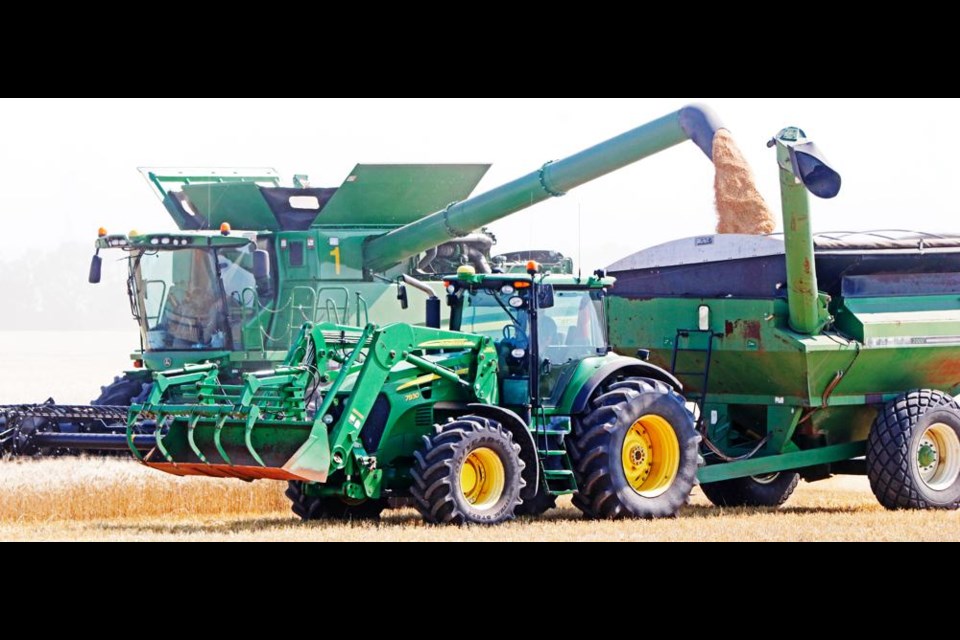Farmers in southeast Saskatchewan were again in the fields swathing and combining, after some scattered showers caused a brief delay in harvest activities.
Harvest is 42 per cent completed in the southeast, up from 30 per cent the week before, and an additional 26 per cent is swathed or ready to straight cut.
Provincially, harvest is 36 per cent completed with an additional 30 per cent swathed or ready for straight-cutting.
In the Weyburn crop district (2A), harvest is 45 per cent combined, and in the Radville-Lake Alma area (3ASE), it’s 66 per cent combined.
For farmer Dale Paslawski in the Cedoux area, he was about 65 per cent completed harvest as of Friday, even after two delays by rain showers in the last couple of weeks, and estimated that as long as the weather holds over the long weekend, he will be about 90 per cent completed by Tuesday, with a number of producers completely finished by that point.
He was waiting for his durum crops to dry before resuming those fields, but he noted with wind and sun there has been some bleaching and a loss of grade.
“We have a quarter of canola to combine soon too, but will concentrate on durum first,” said Paslawski, adding the yield has been below average so far.
He is well ahead of most years in harvest progress, he said, and a few producers are nearly finished their harvest for the year.
Broken down by crops in the southeast region, winter wheat is 99 per cent combined; fall rye is 79 per cent combined, with 21 per cent as greenfeed; spring wheat is 48 per cent combined, with 24 per cent ready to straight-combine; durum is at 46 per cent with 27 per cent ready to straight-combine, and barley is 50 per cent combined, with 11 per cent ready to straight-combine, and 13 per cent as greenfeed.
Oats are 48 per cent combined, with 10 per cent ready to be straight combined and 17 per cent is greenfeed; field peas are 99 per cent combined; lentils are 94 per cent combined with five per cent ready to be straight combined; and chickpeas are 38 per cent combined, with six per cent ready for straight combining.
Canaryseed is five per cent combined with 31 per cent ready for straight combining; canola is 19 per cent combined with 17 per cent swathed and 25 per cent ready for straight combining; mustard is 44 per cent combined with 36 per cent ready for straight combining; soybeans are 40 per cent combined with five per cent ready for straight combining; and harvest has just begun on flax, with one per cent combined, five per cent swathed and one per cent ready for straight combining.
Rainy weather has resulted in downgrading of cereal crops and pulses, but has given pastures a chance to recover some from the drought over the summer.
Rainfall amounts in the Weyburn area ranged from three millimetres in the RM of Wellington and eight mm in the RM of Weyburn, to 32 mm in the RM of Brokenshell, 2.5 mm in the RM of Francis and 24 mm in the RM of Laurier.
Topsoil moisture conditions have improved slightly with the showers, with cropland topsoil moisture rated as 57 per cent adequate, 36 per cent short and seven per cent very short.
Hay and pasture land topsoil moisture is rated as 27 per cent adequate, 60 per cent short and 13 per cent very short.
Crop damaged was attributed to heavy rains, strong winds, insects and hail, with one producers reporting severe damage to as much as 1,500 acres of canola due to hail. The total extent of hail damage for the region is not known at this time, but it is likely several fields were lost where the hail was the most severe.
Producers started to move cattle, are hauling water and some are waiting for conditions to dry up so they can resume harvest.



